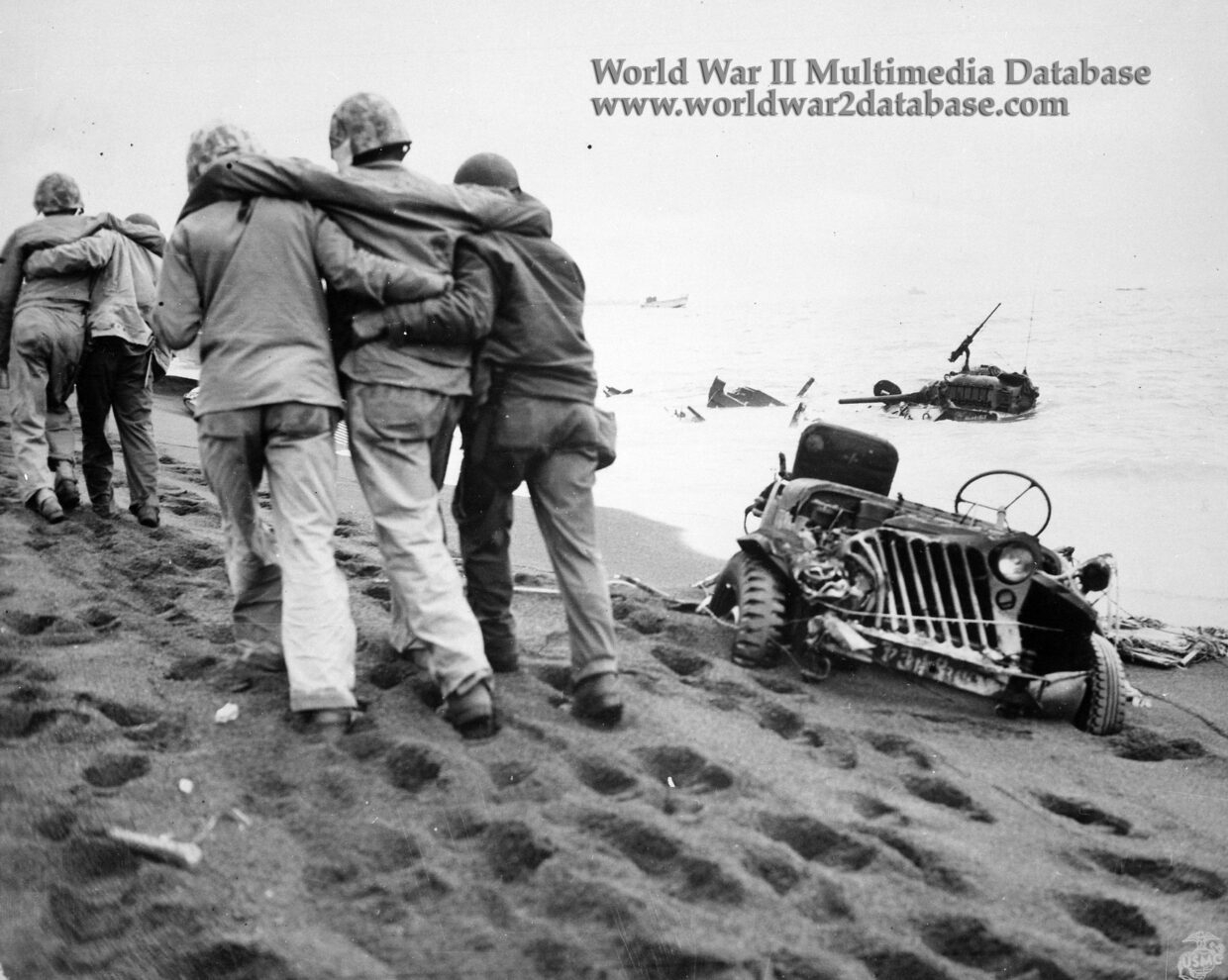| Wounded Marines are helped to an aid station by Navy corpsmen and Marine walking wounded. From the post-battle analysis by Medical Logistic Section of Commander in Chief Pacific: “On the basis of the Army Field Medical Manual, as modified by recent experience and the most reliable evaluation of enemy potential to be gained by aerial observation and combined intelligence, it was estimated that our losses would approximate 20 percent of the forces engaged. Of these 25 percent would be killed in action, 25 percent would be returned to duty locally, and 50 percent would be evacuated. Taking into consideration civilian casualties and enemy wounded to whom we were likely to be required to furnish medical care, definite plans were formulated with regard to evacuation policy, the number of beds and ships required for hospitalization and evacuation, and the volume of medical supplies to be ordered. Each medical company and corps medical battalion had equipment for a 144-bed hospital, twice the number allotted prior to the Marianas campaign, making available approximately 3,592 beds. It was also planned by the Eighth Field Depot, scheduled to arrive about D-day-plus-10, to add to their stock a sufficient amount of cots, tents, blankets, and mess gear for another 1,500 beds. The chain of evacuation of casualties included 4 LST(H)‘s or evacuation control LST‘s, specially equipped with medical personnel and supplies and designated to make preliminary “screening“ examinations of casualties and distribute them equally among the transports and hospital ships. One LST(H) was available for each of the invasion beaches, making two for each Marine division. All ships, LVT or DUKW, that evacuated wounded from beaches were to proceed to their respective evacuation control LST(H). Those casualties unable to endure the trip to a transport or hospital ship were to be transferred immediately to an LST(H) for treatment, while less seriously wounded patients were unloaded onto a barge alongside the LST(H) and then transferred to LCVP‘s for further transfer to transport or hospital ship. Aboard each LST(H) were 4 surgeons and 27 corpsmen, increased on arrival at the objective by the transfer of one beach party medical section (1 medical officer and 8 corpsmen) from an APA, giving each LST(H) 5 surgeons and 35 corpsmen. At all times these beach party medical sections were on call by the Transport Squadron Commander. Two hospital ships and one APH were designated to evacuate patients to Saipan, where 1,500 beds were available, and to Guam, where there were 3,500 beds. Air evacuation of casualties to the Marianas was to begin as soon as field facilities would permit. Experience gained in the Marianas campaign had emphasized the necessity of having the casualties screened by a qualified flight surgeon to insure proper selection of patients for evacuation by air. Medical personnel and adequate medical supplies and equipment were to be aboard each plane.“ | |
| Image Filename | wwii1037.jpg |
| Image Size | 1.69 MB |
| Image Dimensions | 2934 x 2343 |
| Photographer | Jones, Eugene |
| Photographer Title | Corporal Marine Corps |
| Caption Author | Jason McDonald |
| Date Photographed | February 20, 1945 |
| Location | Beach |
| City | Iwo Jima |
| State or Province | Bonin Islands |
| Country | Japan |
| Archive | National Archives and Records Administration |
| Record Number | |
| Status | Caption ©2007, ©2024 MFA Productions LLC Image in the Public Domain |

Author of the World War II Multimedia Database

